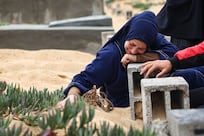Cities in the Middle East and North Africa are centres of innovation and investment, pivotal to economic growth and development across the region. At the same time, they are vulnerable to severe impact from a range of challenges, shocks and stresses that can be both natural and man-made. The growth of sustainable cities needs to be disaster-proofed.
From emergency planning to infrastructure investment, from adaptations in urban planning to risk financing: resilience and sustainability are two complementary paradigms of urban development in the Mena region. One cannot exist without the other. We should go beyond conventional approaches to risk reduction and advocate a forward-looking approach to urban development, encompassing the spatial, physical, functional and organisational dimensions of any inhabited settlement. A resilient city assesses, plans and acts in preparation for all kinds of hazards to enhance lives, foster an environment for investment and drive positive change.
Urbanisation trends continue to transform cities into unique hubs for services and housing, and to fulfil the promise of social inclusion and better social and economic opportunities for all citizens. However, if not properly managed and planned, these same trends can put a severe strain on urban water, waste, housing, energy and utility systems, unleashing long-term stresses on their efficiency and exposing their weaknesses, particularly when impacted by internal or external forces.
Most Mena cities are increasingly exposed to natural disasters such as flood, extreme heat or drought and climate-related shocks. What we have been observing in the region is that while the number of natural disasters around the world has almost doubled since the 1980s, it has almost tripled in Mena countries, with more than 370 natural disasters affecting 40 million people over the last 30 years, costing $20 billion.
The impact of these disasters on cities has been aggravated by a number of factors, including the rise in population density. In total, 62 per cent of Mena population live in cities while the urban population is expected to double by 2040. Water scarcity, migration to cities from rural areas and from neighbouring countries, flawed policies affecting cities, and climate change all have a lasting impact on Middle Eastern cities.
Last year there were more than 70 million people forcibly displaced around the world, according to the UN Refugee Agency. Syria accounted for most of the 13.6m newly displaced people worldwide. More than 80 per cent of forcibly displaced people from the region (primarily from Syria, Iraq and Yemen) now live in towns and cities. The urbanisation of forced displacement means the displaced are no longer in isolated areas but merged into existing urban populations. Their move to cities is often based on a perception that cities offer better economic opportunities, increased security, a degree of anonymity, greater access to services and closer proximity to markets.
In fact, the urban spatial footprint can increase rapidly as a result of an influx from displacement, as seen in Beirut or Amman. A large influx of displaced people arriving in cities and towns can double or triple population growth rates in months or weeks. While the impact on cities such as Amman will be somewhat noticeable, expansion is most visible in smaller municipalities such as Mizyara and Zahle in Lebanon, and Mafraq, Zaatari and Ramtha in northern Jordan, where populations have doubled in some cases and new settlement development drives rapid expansion of the urban footprint.
Most Mena governments have embarked on resilience and development in response - from setting up early-warning systems, building institutions and infrastructure to better handle disasters and gathering an accurate picture of the risks they face.
The city of Jeddah in Saudi Arabia, which was affected by flooding in 2009 and 2011, has undertaken significant steps towards flood-risk reduction by improving drainage infrastructure and land use planning. Dubai has implemented development for urban search and rescue, contingency planning, firefighting and emergency response. The Jordanian port city of Aqaba has instigated a variety of initiatives regarding earthquake risk reduction, including risk assessment, public awareness, urban search and rescue, and community voluntary teams. Meanwhile Fez in Morocco has community-level disaster risk management initiatives and the coastal city of Byblos in Lebanon, known to be one of the oldest continuously inhabited cities in the world, has an action plan to mitigate risks, including identifying opportunities that the city can take to improve its resilience.
These good practices display the importance that concerned city authorities attach to disaster risk reduction for the safety of their populations. There is a need to replicate such good practices on a wider scale in the region.
But to implement these plans successfully and manage increasingly large and complex urban systems, there is a need for better co-ordination at a central and local level, increased participation of the private sector in urban development and a devolution of responsibilities and budgets to local authorities.
We also need to make sure fast-growing cities do not lock in high rates of carbon emission or put people at further risk of disaster. It will take a combined effort from the public and private sector to build resilience in all Mena cities.
Jamal Saghir is a former director of the World Bank Group and an affiliated scholar at the Issam Fares Institute for Public Policy and International Affairs at the American University of Beirut






